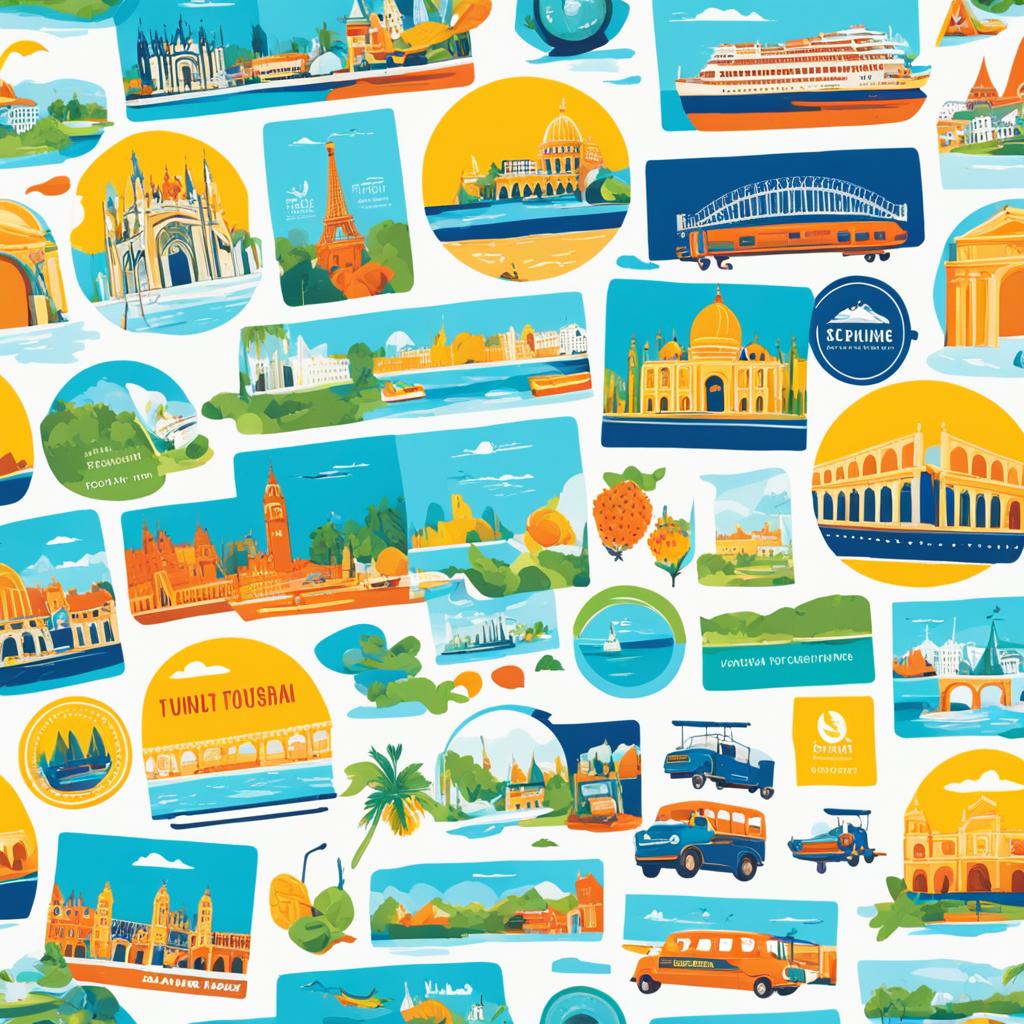Are you curious about the different types of products that contribute to your travel experience? When planning a trip, it’s essential to understand the various elements that make up the tourism industry. One crucial aspect is the distinction between tangible and intangible tourism products. These products shape your travel experience and play a significant role in destination marketing.
Tangible tourism products refer to physical goods or services that can be seen, touched, or tasted. They include accommodations, transportation, attractions, and souvenirs. On the other hand, intangible tourism products are experiences or services that are not physical in nature, such as local traditions, cultural heritage, gastronomy, and the overall visitor experience.
But why is it important to differentiate between these two types of products? How do tangible and intangible products impact your travel experience, and how do they contribute to destination marketing? In this article, we will delve deeper into these questions and explore the characteristics and significance of both tangible and intangible tourism products. So, let’s begin our journey into the world of tangible and intangible tourism products!
Distinguishing Between Tangible and Intangible Products
When it comes to distinguishing between tangible and intangible products in the tourism industry, the key factor is whether the product can be physically experienced or not. Tangible tourism products can be seen, felt, or tasted before making a purchase, while intangible products cannot be “touched” beforehand.
For example, a flight ticket is an intangible service because it is purchased in advance, but the experience of flying only happens when the traveler is on the plane. Additionally, intangible tourism products are highly variable as they depend on factors like location, time, environment, and service providers.
Understanding the difference between tangible and intangible products is crucial for destination marketing and creating memorable travel experiences.
| Tangible Products | Intangible Products |
|---|---|
| Accommodations | Cultural heritage |
| Transportation | Local traditions |
| Attractions | Gastronomy |
| Souvenirs | Overall visitor experience |
The Characteristics of Tangible Tourism Products

Tangible tourism products possess unique qualities that set them apart from intangible products. One prominent characteristic is their physicality, as these products can be seen, felt, and/or tasted before making a purchase. This allows customers to physically examine the product, evaluate its quality, and ascertain its suitability to their needs and preferences.
A significant advantage of tangible tourism products is their longer lifespan compared to intangible ones. Unlike intangible products that are fleeting experiences, tangible products can be stored and used over an extended period of time. For instance, a physical souvenir acquired during a trip can serve as a tangible keepsake, reminding you of cherished travel memories for years to come.
By offering the ability to interact with and evaluate products before purchase, tangible tourism products provide a sense of tangibility and allow travelers to make informed decisions. They add a tangible dimension to the overall travel experience, enhancing the satisfaction and enjoyment of tourists.
| Characteristics | Examples |
|---|---|
| Tangible and physical | Accommodations, transportation, attractions, souvenirs |
| Can be examined before purchase | Hotels can be viewed online, souvenirs can be touched in-store |
| Longer lifespan | Souvenirs can be kept for years, transportation services can be used multiple times |
Table: Characteristics of Tangible Tourism Products.
Tangible tourism products provide concrete and tangible benefits to travelers in terms of physical presence, assessability, and lasting value. Their discernible attributes make them an essential component of the tourism industry.
The Nature of Intangible Tourism Products

Intangible tourism products have unique qualities that set them apart from tangible products. Unlike tangible products, intangible products cannot be separated from the service provider or experienced before payment. They are created and consumed simultaneously, and their existence is fleeting. Intangible products cannot be stored and must be experienced in the moment. For example, cultural heritage, local traditions, and gastronomy are intangible tourism products that are created and enjoyed in real-time.
Intangible tourism products, such as cultural heritage, involve experiences that cannot be physically touched or seen before experiencing them. These products are often deeply entrenched in a destination’s history, customs, and traditions, offering visitors the opportunity to immerse themselves in a rich and authentic cultural experience.
Cultural heritage, for example, encompasses historical landmarks, museums, and sites of historical significance. Whether exploring ancient ruins, visiting a sacred temple, or admiring a renowned artwork, these intangible products showcase the depth of a destination’s history and cultural heritage.
Local traditions, on the other hand, provide visitors with an opportunity to participate in unique and culturally significant activities. This could include attending religious ceremonies, festivals, or witnessing traditional performances. By engaging in these intangible experiences, travelers gain a deeper understanding and appreciation for the local culture.
Gastronomy is another example of an intangible tourism product. Local cuisine and traditional food experiences offer visitors the chance to taste and savor the flavors of a destination. From street food markets to gourmet dining experiences, gastronomy captures the essence of a culture through its flavors and culinary traditions.
Overall, intangible tourism products add depth and authenticity to the visitor experience. They provide opportunities for cultural exchange, personal growth, and emotional connections. By embracing and showcasing these intangible products, destinations can create memorable travel experiences and cultivate a strong tourism image.
Examples of Intangible Tourism Products

Intangible tourism products encompass a wide range of experiences and services that create unique and unforgettable memories for travelers. These intangible aspects contribute to the emotional journey of the visitors, allowing them to connect with the destination on a deeper level. Here are some examples of intangible tourism products:
Cultural Heritage
One prime example of an intangible tourism product is cultural heritage. Historical sites, such as ancient ruins, castles, or UNESCO World Heritage sites, offer visitors the opportunity to learn about the local culture and history. Museums also fall under this category, as they provide insights into art, artifacts, and the stories of a particular place.
Local Traditions and Events
Festivals and celebrations are intangible tourism products that allow visitors to experience the vibrant culture and traditions of a destination. From lively carnivals to religious processions, these events provide a unique and immersive experience for travelers. They offer a glimpse into the local way of life and showcase the authenticity of the destination.
Gastronomy
One of the most enjoyable aspects of travel is indulging in local cuisine. Gastronomy plays a significant role as an intangible tourism product. Tasting regional delicacies, exploring local markets, or participating in cooking classes enable visitors to engage with the local culture through their taste buds. It’s a sensory experience that creates lasting memories.
Overall Contribution
These examples of intangible tourism products contribute to the overall visitor experience by offering a deeper understanding of a destination’s heritage, traditions, and flavors. They evoke emotions, foster connections, and shape the memories that travelers carry with them long after their journey ends. These intangible aspects are what make each travel experience truly distinctive and unforgettable.
| Intangible Tourism Products | Description |
|---|---|
| Cultural Heritage | Includes historical sites, museums, and UNESCO World Heritage sites that showcase the local culture and history. |
| Local Traditions and Events | Encompasses festivals, celebrations, and religious processions that provide immersive experiences into the destination’s traditions. |
| Gastronomy | Showcases local cuisine, traditional food experiences, and culinary activities that allow visitors to engage with the local culture through taste. |
The Role of Tangible and Intangible Products in Destination Marketing
Tangible and intangible tourism products play a vital role in destination marketing. When promoting a destination, it is important to showcase both tangible and intangible products to attract different types of travelers and highlight the unique offerings available.
Tangible products, such as accommodations, transportation, and attractions, provide the infrastructure and amenities that make a destination appealing to travelers. By featuring these tangible products in marketing campaigns, destinations can showcase the range of services available and entice potential visitors to choose their location.
“When planning your vacation, you want to ensure that you have comfortable accommodations, exciting attractions, and convenient transportation options. Marketing tangible products allows destinations to highlight these essential aspects, giving travelers the confidence to choose them as their preferred location.”
On the other hand, intangible products are the experiences and cultural aspects that make a destination unique and authentic. These include elements such as cultural heritage, local traditions, gastronomy, and the overall visitor experience. By emphasizing these intangible products in destination marketing, locations can create a sense of authenticity and offer travelers an unforgettable experience.
“As a traveler, you are seeking more than just a place to stay or things to do. You want to immerse yourself in the culture, connect with local traditions, and savor the local flavors. Destination marketing that focuses on intangible products highlights the authenticity and distinctiveness of a location, ensuring you have an enriching and memorable journey.”
With a combination of tangible and intangible products, destinations can cater to diverse traveler preferences and create a comprehensive marketing approach that showcases the complete experience they have to offer. By promoting both the physical amenities and the cultural richness of a location, destinations can attract a wider audience and leave a lasting impression on visitors.
Comparing Tangible and Intangible Products in Destination Marketing
| Tangible Products | Intangible Products |
|---|---|
| Can be physically experienced | Emotional and cultural experiences |
| Highlight amenities and services | Emphasize authenticity and uniqueness |
| Provide convenience and comfort | Create lasting memories |
The Importance of Tangible and Intangible Products in the Visitor Experience
Both tangible and intangible tourism products play a crucial role in shaping the overall visitor experience. While tangible products provide the necessary infrastructure and services, ensuring a comfortable and convenient stay for travelers, intangible products add depth and authenticity to the experience, allowing visitors to immerse themselves in the local culture and traditions.
Tangible tourism products, such as accommodations, transportation, and attractions, are tangible and observable elements that contribute to the physical comfort and convenience of travelers. These products provide the necessary amenities and services that enable travelers to have a seamless and enjoyable trip. For example, a well-equipped hotel room offers a comfortable space to rest and relax after a long day of exploring, while efficient transportation options make it easier for visitors to navigate the destination.
On the other hand, intangible products are experiential and emotional in nature, enhancing the visitor experience by providing opportunities for cultural immersion and connection. These intangible products, like local traditions, cultural heritage, and gastronomy, offer unique and authentic experiences that create lasting memories. Engaging with local traditions, attending cultural events, and sampling traditional cuisine all contribute to a deeper understanding and appreciation of the destination’s culture and heritage.
Moreover, the combination of tangible and intangible products creates a holistic and memorable travel experience that leaves a lasting impression on the travelers. When tangible infrastructure and services are seamlessly integrated with intangible cultural experiences, visitors are able to fully immerse themselves in the destination and create meaningful connections with the local community.
| Tangible Products | Intangible Products |
|---|---|
| Accommodations | Local traditions |
| Transportation | Cultural heritage |
| Attractions | Gastronomy |
By understanding the importance of both tangible and intangible products, destination marketers can design and promote tourism experiences that offer a well-rounded and enriching journey for visitors. This integrative approach not only enhances the visitor experience but also showcases the unique cultural and natural assets of a destination, making it more attractive to a wide range of travelers.
The Growing Significance of Intangible Cultural Heritage in Tourism
Intangible cultural heritage is playing an increasingly significant role in the world of tourism. As travel becomes more popular globally, travelers are now seeking authentic experiences that allow them to engage with local cultures and traditions. This has led to unique local and regional traditions and cultural practices becoming a distinguishing factor in attracting tourists.
The preservation and promotion of intangible cultural heritage have become crucial for destinations looking to differentiate themselves and create a strong tourism image. Visitors are no longer satisfied with mere sightseeing; they want to immerse themselves in the local culture and experience the intangible elements that make a destination truly special.
Whether it’s participating in traditional festivals, learning about ancient rituals, or indulging in local cuisine, tourists are drawn to destinations that offer vibrant intangible cultural heritage experiences. These experiences provide a deeper understanding of the local community, foster cultural exchange, and create lasting memories for travelers.
Destinations that recognize the significance of intangible cultural heritage in tourism can leverage it to their advantage. By preserving and promoting their unique cultural practices, they not only attract more visitors but also contribute to the overall sustainable development of the local community. This makes intangible cultural heritage a valuable asset for both tourism stakeholders and the destination itself.


